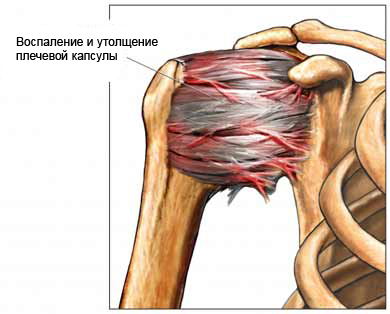Adhesive capsulitis – closed operation – Frozen shoulder – closed operation
Description closed operation treatment of adhesive capsulitis
Adhesive capsulitis – thickening of the shoulder joint. It arises as a result of inflammation capsule, surrounding the shoulder joint. This reduces the range movements and shoulder pains. Another name for the disease – frozen shoulder.
During arthroscopic surgery the doctor moves the arm at the shoulder joint. The purpose operation is, to increase the range of motion, removing the inflamed tissue from the moving part of the shoulder joint.

Indications for the treatment of closed transactions adhesive capsulitis
The doctor may recommend a closed operation, if other methods of assistance were unsuccessful. This procedure may relieve pain and increase mobility of the shoulder joint in some patients. But, may remain some pain and swelling in joints. If the closed manipulation were unsuccessful, It may need arthroscopic surgery.
Possible complications during surgery closed treatment of adhesive capsulitis
Complications are rare, but we can not guarantee their complete lack of. If you plan to have surgery, you need to know about possible complications, which may include:
- Bleeding;
- Infection;
- Pain;
- Damage to nerves;
- Soft tissue injuries;
- Ankylosis;
- Fracture;
- The negative reaction to anesthesia.
Some factors, that may increase the risk of complications include:
- Recently transferred or chronic illness;
- Taking certain medications, notably increase the risk of bleeding (eg, aspirin);
- Smoking or drinking alcohol;
- Previous shoulder surgery.
As a conductive closed manipulation?
Preparing for Surgery
Before the operation it is necessary to pass the following tests:
- Medical checkup;
- X-ray examination, to make pictures of bones;
- MRT – test, which uses magnetic waves, to make pictures of internal organs.
Perhaps it will be necessary to stop taking certain medicines a week before surgery, eg:
- Aspirin or other anti-inflammatory drugs;
- Do not take blood thinners, such as warfarin, Clopidogrel.
Anesthesia
The decision about the type of anesthesia, the doctor takes:
- General anesthesia, during handling the patient sleeps;
- Partial anesthesia – in the operative shoulder pain medication administered, which makes it insensitive to pain.
Activity description
The doctor turns his shoulder upward and outward. These actions do accrued in inflamed tissue elastic, that enhances and increases the range of motion.
After operation
After surgery, the patient is sent to the recovery room until the end of anesthesia.
How long does the surgery?
The operation takes 45 – 60 minutes.
Will it hurt?
Anesthesia will prevent pain during the procedure. After manipulations may be felt a small pain in the shoulder. Pain relief appropriate pain medicine.
The time spent in hospital
If there are no complications, the patient can leave immediately after manipulation.
Postoperative care
Shoulder pain can be felt throughout 1 – 2 weeks after surgery.
For a normal recovery, you need to do the following:
- Applying ice on the swollen area for 24 – 48 hours after surgery. Duration of treatment – 20 – 30 minutes at a time;
- Sleeping or sitting in a chair. Elbow pillow;
- It is necessary to do special exercises, to increase the mobility of the shoulder joint;
- We must stick to the doctor's recommendations.
It is necessary to go to the hospital in cases
- Cough, shortness of breath or chest pain;
- Severe pain and swelling of the arm;
- Severe nausea or vomiting.
- Constant tingling or numbness, especially in the hands and wrists.
